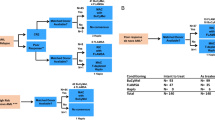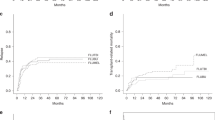Abstract
Allogeneic hematopoietic SCT is well established as a potentially curative therapy for children and adults with both malignant and nonmalignant diseases. However, myeloablative SCT is associated with significant short- and long-term complications. The goals of a reduced intensity-conditioning (RIC) regimen are to prevent graft rejection and establish stable donor-derived hematopoiesis at a level sufficient for cure of the underlying disease and, in patients with hematologic malignancy, to provide a GVL effect, while decreasing the short- and long-term complications associated with myeloablative conditioning therapy. RIC regimens have enabled SCT to be performed in children with preexisting comorbidities that preclude conventional conditioning. RIC-SCT has been most extensively studied in patients with nonmalignant disorders and for some of these, including primary immunodeficiencies and hemophagocytic lymphohistiocytosis, sufficient data now exist to support its routine use even in patients without comorbidity. Less data exist on RIC-SCT for children with hematologic malignancies and at present this should be restricted to children who are not candidates for, or have relapsed after, myeloablative SCT. Here we review available data on the use of RIC-SCT in pediatric patients, highlighting important clinical lessons and areas that require further study.
This is a preview of subscription content, access via your institution
Access options
Subscribe to this journal
Receive 12 print issues and online access
$259.00 per year
only $21.58 per issue
Buy this article
- Purchase on Springer Link
- Instant access to full article PDF
Prices may be subject to local taxes which are calculated during checkout





Similar content being viewed by others
References
Thomas ED . Karnofsky Memorial Lecture. Marrow transplantation for malignant diseases. J Clin Oncol 1983; 1: 517–531.
Champlin R, Khouri I, Shimoni A, Gajewski J, Kornblau S, Molldrem J et al. Harnessing graft-versus-malignancy: non-myeloablative preparative regimens for allogeneic haematopoietic transplantation, an evolving strategy for adoptive immunotherapy. Br J Haematol 2000; 111: 18–29.
Crawley C, Iacobelli S, Bjorkstrand B, Apperley JF, Niederwieser D, Gahrton G . Reduced-intensity conditioning for myeloma: lower nonrelapse mortality but higher relapse rates compared with myeloablative conditioning. Blood 2007; 109: 3588–3594.
Crawley C, Szydlo R, Lalancette M, Bacigalupo A, Lange A, Brune M et al. Outcomes of reduced-intensity transplantation for chronic myeloid leukemia: an analysis of prognostic factors from the Chronic Leukemia Working Party of the EBMT. Blood 2005; 106: 2969–2976.
Del Toro G, Satwani P, Harrison L, Cheung YK, Brigid Bradley M, George D et al. A pilot study of reduced intensity conditioning and allogeneic stem cell transplantation from unrelated cord blood and matched family donors in children and adolescent recipients. Bone Marrow Transplant 2004; 33: 613–622.
Gomez-Almaguer D, Ruiz-Arguelles GJ, Tarin-Arzaga Ldel C, Gonzalez-Llano O, Jaime-Perez JC, Lopez-Martinez B et al. Reduced-intensity stem cell transplantation in children and adolescents: the Mexican experience. Biol Blood Marrow Transplant 2003; 9: 157–161.
Duerst R, Jacobsohn D, Tse WT, Kletzel M . Efficacy of reduced intensity conditioning (RIC) with FLU-BU-ATG and allogeneic hematopoietic stem cell transplantation (HSCT) for pediatric ALL. Blood 2004; 104: 2314 (abstract).
Roman E, Cooney E, Harrison L, Militano O, Wolownik K, Hawks R et al. Preliminary results of the safety of immunotherapy with gemtuzumab ozogamicin following reduced intensity allogeneic stem cell transplant in children with CD33+ acute myeloid leukemia. Clin Cancer Res 2005; 11 (19 Part 2): 7164s–7170s.
Claviez A, Klingebiel T, Beyer J, Nurnberger W, Ehninger G, Suttorp M et al. Allogeneic peripheral blood stem cell transplantation following fludarabine-based conditioning in six children with advanced Hodgkin's disease. Ann Hematol 2004; 83: 237–241.
Kolb HJ, Schattenberg A, Goldman JM, Hertenstein B, Jacobsen N, Arcese W et al. Graft-versus-leukemia effect of donor lymphocyte transfusions in marrow grafted patients. European Group for Blood and Marrow Transplantation Working Party Chronic Leukemia. Blood 1995; 86: 2041–2050.
Kolb HJ, Schmid C, Barrett AJ, Schendel DJ . Graft-versus-leukemia reactions in allogeneic chimeras. Blood 2004; 103: 767–776.
Raghuram C, Wynn R, Will A, Carr T, Veys P, Webb D et al. Reduced-intensity conditioning in first and second allograft in children without immunodeficiency: experience of three British transplant centres. Bone Marrow Transplant 2004; 33 (Suppl 1): s48.
Nagler A, Or R, Naparstek E, Varadi G, Slavin S . Second allogeneic stem cell transplantation using nonmyeloablative conditioning for patients who relapsed or developed secondary malignancies following autologous transplantation. Exp Hematol 2000; 28: 1096–1104.
Veys P, Rao K, Amrolia P . Stem cell transplantation for congenital immunodeficiencies using reduced-intensity conditioning. Bone Marrow Transplant 2005; 35 (Suppl 1): S45–S47.
Rao K, Amrolia PJ, Jones A, Cale CM, Naik P, King D et al. Improved survival after unrelated donor bone marrow transplantation in children with primary immunodeficiency using a reduced-intensity conditioning regimen. Blood 2005; 105: 879–885.
Burroughs LM, Storb R, Leisenring WM, Pulsipher MA, Loken MR, Torgerson TR et al. Intensive postgrafting immune suppression combined with nonmyeloablative conditioning for transplantation of HLA-identical hematopoietic cell grafts: results of a pilot study for treatment of primary immunodeficiency disorders. Bone Marrow Transplant 2007; 40: 633–642.
Cohen JM, Cooper N, Chakrabarti S, Thomson K, Samarasinghe S, Cubitt D et al. EBV-related disease following haematopoietic stem cell transplantation with reduced intensity conditioning. Leuk Lymphoma 2007; 48: 256–269.
Cooper N, Rao K, Gilmour K, Hadad L, Adams S, Cale C et al. Stem cell transplantation with reduced-intensity conditioning for hemophagocytic lymphohistiocytosis. Blood 2006; 107: 1233–1236.
Horne A, Janka G, Maarten Egeler R, Gadner H, Imashuku S, Ladisch S et al. Haematopoietic stem cell transplantation in haemophagocytic lymphohistiocytosis. Br J Haematol 2005; 129: 622–630.
Steiner M, Matthes-Martin S, Attarbaschi A, Minkov M, Grois N, Unger E et al. Improved outcome of treatment-resistant high-risk Langerhans cell histiocytosis after allogeneic stem cell transplantation with reduced-intensity conditioning. Bone Marrow Transplant 2005; 36: 215–225.
Vermylen C, Cornu G, Ferster A, Brichard B, Ninane J, Ferrant A et al. Haematopoietic stem cell transplantation for sickle cell anaemia: the first 50 patients transplanted in Belgium. Bone Marrow Transplant 1998; 22: 1–6.
Walters MC, Storb R, Patience M, Leisenring W, Taylor T, Sanders JE et al. Impact of bone marrow transplantation for symptomatic sickle cell disease: an interim report. Multicenter investigation of bone marrow transplantation for sickle cell disease. Blood 2000; 95: 1918–1924.
Iannone R, Casella JF, Fuchs EJ, Chen AR, Jones RJ, Woolfrey A et al. Results of minimally toxic nonmyeloablative transplantation in patients with sickle cell anemia and beta-thalassemia. Biol Blood Marrow Transplant 2003; 9: 519–528.
Krishnamurti L, Blazar BR, Wagner JE . Bone marrow transplantation without myeloablation for sickle cell disease. N Engl J Med 2001; 344: 68.
Schleuning M, Stoetzer O, Waterhouse C, Schlemmer M, Ledderose G, Kolb HJ . Hematopoietic stem cell transplantation after reduced-intensity conditioning as treatment of sickle cell disease. Exp Hematol 2002; 30: 7–10.
van Besien K, Koshy M, Anderson-Shaw L, Talishy N, Dorn L, Devine S et al. Allogeneic stem cell transplantation for sickle cell disease. A study of patients' decisions. Bone Marrow Transplant 2001; 28: 545–549.
Jacobsohn DA, Duerst R, Tse W, Kletzel M . Reduced intensity haemopoietic stem-cell transplantation for treatment of non-malignant diseases in children. Lancet 2004; 364: 156–162.
Childs RW, Clave E, Tisdale J, Plante M, Hensel N, Barrett J . Successful treatment of metastatic renal cell carcinoma with a nonmyeloablative allogeneic peripheral-blood progenitor-cell transplant: evidence for a graft-versus-tumor effect. J Clin Oncol 1999; 17: 2044–2049.
Boelens JJ, Wynn RF, O'Meara A, Veys P, Bertrand Y, Souillet G et al. Outcomes of hematopoietic stem cell transplantation for Hurler's syndrome in Europe: a risk factor analysis for graft failure. Bone Marrow Transplant 2007; 40: 225–233.
Tolar J, Bonfim C, Grewal S, Orchard P . Engraftment and survival following hematopoietic stem cell transplantation for osteopetrosis using a reduced intensity conditioning regimen. Bone Marrow Transplant 2006; 38: 783–787.
Resnick IB, Abdul Hai A, Shapira MY, Bitan M, Hershkovitz E, Schwartz A et al. Treatment of X-linked childhood cerebral adrenoleukodystrophy by the use of an allogeneic stem cell transplantation with reduced intensity conditioning regimen. Clin Transplant 2005; 19: 840–847.
Connor P, Khair K, Liesner R, Amrolia P, Veys P, Ancliff P et al. Stem cell transplantation for children with Glanzmann's thrombasthenia. Br J Haematol 2007 (in press).
Chen YB, Spitzer TR . Current status of reduced-intensity allogeneic stem cell transplantation using alternative donors. Leukemia 2007; September 6, e-pub ahead of print; doi: 10.1038/sj.leu.2404932.
Brunstein CG, Barker JN, Weisdorf DJ, Defor TE, Miller JS, Blazar BR et al. Umbilical cord blood transplantation after nonmyeloablative conditioning: impact on transplant outcomes in 110 adults with hematological disease. Blood 2007; 110: 3064–3070.
Bradley MB, Satwani P, Baldinger L, Morris E, van de Ven C, Toro GD et al. Reduced intensity allogeneic umbilical cord blood transplantation in children and adolescent recipients with malignant and non-malignant diseases. Bone Marrow Transplant 2007; 40: 621–631.
Bader P, Kreyenberg H, Hoelle W, Dueckers G, Handgretinger R, Lang P et al. Increasing mixed chimerism is an important prognostic factor for unfavorable outcome in children with acute lymphoblastic leukemia after allogeneic stem-cell transplantation: possible role for pre-emptive immunotherapy? J Clin Oncol 2004; 22: 1696–1705.
Cohen J, Gandhi M, Naik P, Cubitt D, Rao K, Thaker U et al. Increased incidence of EBV-related disease following paediatric stem cell transplantation with reduced-intensity conditioning. Br J Haematol 2005; 129: 229–239.
Chakrabarti S, Mackinnon S, Chopra R, Kottaridis PD, Peggs K, O'Gorman P et al. High incidence of cytomegalovirus infection after nonmyeloablative stem cell transplantation: potential role of Campath-1 H in delaying immune reconstitution. Blood 2002; 99: 4357–4363.
Nachbaur D, Larcher C, Kircher B, Eibl G, Nussbaumer W, Gunsilius E et al. Risk for cytomegalovirus infection following reduced intensity allogeneic stem cell transplantation. Ann Hematol 2003; 82: 621–627.
Kampmann B, Cubitt D, Walls T, Naik P, Depala M, Samarasinghe S et al. Improved outcome for children with disseminated adenoviral infection following allogeneic stem cell transplantation. Br J Haematol 2005; 130: 595–603.
Avivi I, Chakrabarti S, Milligan DW, Waldmann H, Hale G, Osman H et al. Incidence and outcome of adenovirus disease in transplant recipients after reduced-intensity conditioning with alemtuzumab. Biol Blood Marrow Transplant 2004; 10: 186–194.
Upton A, Kirby KA, Carpenter P, Boeckh M, Marr KA . Invasive aspergillosis following hematopoietic cell transplantation: outcomes and prognostic factors associated with mortality. Clin Infect Dis 2007; 44: 531–540.
Kyriacou C, Kottaridis PD, Eliahoo J, McKeag N, Bomford J, McGarrigle HH et al. Germ cell damage and Leydig cell insufficiency in recipients of nonmyeloablative transplantation for haematological malignancies. Bone Marrow Transplant 2003; 31: 45–50.
Acknowledgements
This research was supported in part by grants from the Pediatric Cancer Research Foundation, Marisa Fund, Sonia Scaramella Fund, Brittany Barron and Bevanmar Foundation.
Author information
Authors and Affiliations
Corresponding author
Rights and permissions
About this article
Cite this article
Satwani, P., Cooper, N., Rao, K. et al. Reduced intensity conditioning and allogeneic stem cell transplantation in childhood malignant and nonmalignant diseases. Bone Marrow Transplant 41, 173–182 (2008). https://doi.org/10.1038/sj.bmt.1705923
Received:
Revised:
Accepted:
Published:
Issue Date:
DOI: https://doi.org/10.1038/sj.bmt.1705923
Keywords
This article is cited by
-
Dynamics of recent thymic emigrants in pediatric recipients of allogeneic hematopoetic stem cell transplantation
Bone Marrow Transplantation (2022)
-
Reduced-toxicity myeloablative conditioning regimen using fludarabine and full doses of intravenous busulfan in pediatric patients not eligible for standard myeloablative conditioning regimens: Results of a multicenter prospective phase 2 trial
Bone Marrow Transplantation (2022)
-
A fludarabine and melphalan reduced-intensity conditioning regimen for HSCT in fifteen chronic granulomatous disease patients and a literature review
Annals of Hematology (2022)
-
Impact of low-dose irradiation and in vivo T-cell depletion on hematopoietic stem cell transplantation for non-malignant diseases using fludarabine-based reduced-intensity conditioning
Bone Marrow Transplantation (2019)
-
Long-term outcomes of fludarabine, melphalan and antithymocyte globulin as reduced-intensity conditioning regimen for allogeneic hematopoietic stem cell transplantation in children with primary immunodeficiency disorders: a prospective single center study
Bone Marrow Transplantation (2016)



